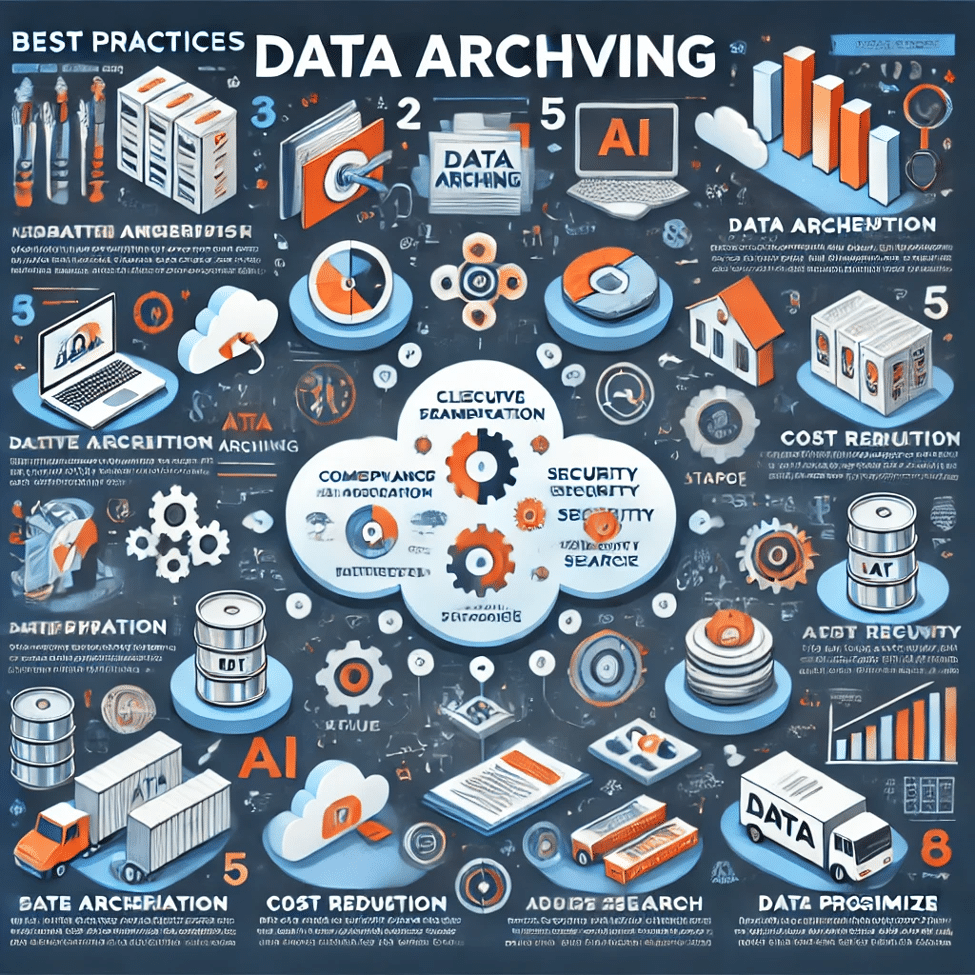With data growing at an unprecedented rate, businesses and organizations must adopt a structured approach to managing their digital assets. Data archiving goes beyond simple storage—it ensures data is securely retained, easily accessible, and compliant with industry regulations. Unlike backups, which focus on disaster recovery, archives store rarely used but valuable data, reducing operational costs and improving system performance.
This guide outlines essential strategies for effective data archiving, ensuring compliance, security, and efficiency.
1. Understanding the Purpose of Data Archiving
Data archiving serves multiple purposes, including:
- Regulatory Compliance: Many industries (e.g., healthcare, finance) require long-term data retention to meet regulations such as GDPR, HIPAA, and SOX.
- Cost Reduction: Storing outdated or infrequently used data in active databases increases storage costs and slows down system performance.
- Enhanced Security: Archiving protects sensitive information from unauthorized access by implementing encryption and access control mechanisms.
- Data Preservation: Ensures long-term accessibility of historical records, legal documents, and research data.
2. Classify Data Before Archiving
Not all data requires archiving. A data classification framework helps determine:
- Active Data: Frequently accessed data that should remain on live systems.
- Archivable Data: Infrequently accessed yet valuable data (e.g., financial records, legal documents).
- Obsolete Data: Data that no longer holds value and can be safely deleted.
A data lifecycle policy ensures proper data handling from creation to eventual deletion.
3. Choose the Right Storage Medium

Selecting the right storage solution is critical for security and efficiency. Below is a comparison of key storage options:
| Storage Type | Advantages | Best Use Case |
| Cloud Storage | Scalable, cost-effective, remote access, redundant backup | Businesses needing flexible & remote access |
| On-Premise Storage | Full control, high security, faster access for local users | Highly regulated industries requiring on-site control |
| Tape Storage | Cost-efficient for long-term storage, low energy consumption | Cold storage for archives that are rarely accessed |
| Hybrid Storage | Combination of cloud & on-premise benefits | Companies balancing security & accessibility |
Key Considerations:
- Security Requirements: Industries handling sensitive data (e.g., finance, healthcare) may prefer on-premise or hybrid
- Budget Constraints: Cloud storage offers a pay-as-you-go model, reducing upfront costs.
- Accessibility Needs: Remote teams benefit from cloud-based solutions, while local access requirements may favor on-premise storage.
4. Implement Data Retention Policies
A clear retention policy ensures organizations store data only for as long as necessary to:
- Comply with legal requirements (e.g., financial records must be retained for 5-7 years per IRS guidelines).
- Minimize storage costs by deleting obsolete data.
- Define automatic deletion schedules to prevent unnecessary accumulation.
✅ Action Step: Review industry-specific retention laws such as GDPR (Europe), CCPA (California), and PCI DSS (financial services).
5. Secure Archived Data Against Cyber Threats
Archived data remains a prime target for cyberattacks, making security a top priority.
Security Best Practices: 🔹 Encryption: Apply AES-256 encryption to protect data at rest and in transit.
🔹 Access Control: Implement role-based access (RBAC) to limit retrieval permissions.
🔹 Audit Trails: Maintain detailed logs of data access for compliance verification.
🔹 Air-Gapped Storage: Use offline storage solutions to prevent cyber threats like ransomware attacks.
✅ Case Study: After a ransomware attack on a U.S. hospital system, air-gapped backups enabled full recovery without paying a ransom.
6. Ensure Fast & Reliable Data Retrieval
Archived data should be easily searchable and retrievable without disrupting operations.
Strategies to Improve Data Accessibility: ✔ Metadata Tagging: Attach descriptive labels (date, file type, category) to archived files.
✔ Search Indexing: Use AI-driven search tools to enhance retrieval speed.
✔ Retention Schedules: Regularly review and delete outdated records to avoid clutter.
Example: Legal firms use metadata-driven archiving systems to locate case files instantly.
7. Automate the Archiving Process
Manual data archiving is time-consuming and error-prone. Automation ensures efficiency by:
- Auto-classifying data based on pre-set policies.
- Scheduling archiving at regular intervals.
- Monitoring storage usage and sending alerts for optimization.
Tools & Solutions: ✅ AWS Glacier – Affordable cloud-based archiving
✅ Google Vault – For managing legal & compliance data
✅ Veeam Backup & Replication – Advanced automation & disaster recovery
Industry Insight: 90% of organizations using automated archiving report a 30% reduction in storage costs (Source: Gartner, 2023).
8. Regularly Audit & Optimize Your Archive
A well-maintained archive prevents storage bloat and ensures compliance.
🔍 Key Audit Actions:
- Identify outdated or redundant data for deletion.
- Optimize storage allocation (e.g., move infrequently accessed data to tape storage).
- Validate compliance with industry data protection standards.
✅ Recommended Practice: Conduct quarterly audits to remove non-essential files.
9. Future-Proof Your Archiving Strategy
With rapid technological advancements, organizations must adapt their archiving strategies.
🚀 Emerging Trends: 🔹 AI-Powered Archiving: AI tools predict which data should be archived or deleted.
🔹 Blockchain Storage: Immutable, tamper-proof records for compliance-heavy industries.
🔹 Quantum Storage: Future-proofing against data expansion in the next decade.
✅ Actionable Step: Assess AI-based archiving solutions to automate classification.
Conclusion
Effective data archiving is more than storage—it’s a strategy for security, compliance, and efficiency. By implementing best practices, businesses can: ✔ Secure valuable data from cyber threats
✔ Ensure regulatory compliance and avoid legal risks
✔ Reduce storage costs while maintaining accessibility
💡 Next Step: Download this Data Archiving Checklist to ensure your strategy meets best practices.

